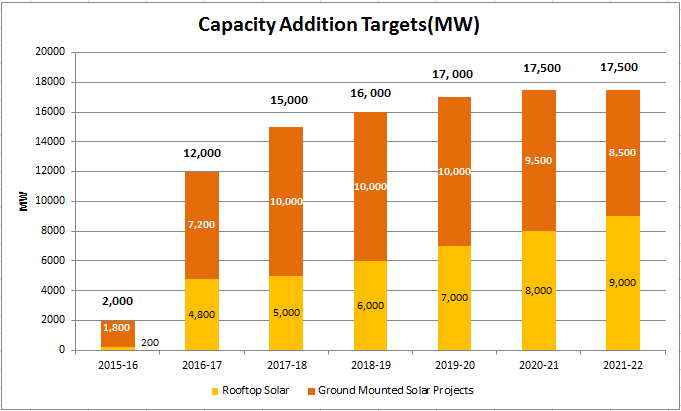The Ministry of New and Renewable Energy(MNRE) has released the year-wise target to achieve the “100 GW by 2022” goal . Last week, MNRE had released the state-wise, month-wise targets of rooftop solar and the announcement today includes the ground-mounted solar installation targets. The targets are given below.

From a modest 2 GW target for the next 9 months of this financial year, the target for the next financial year jumps six-fold and another 25% for the subsequent year.
India Vs China – The inevitable comparison
India’s 100 GW target is extremely ambitious, and no other country other than China(and perhaps USA) has such massive targets. China’s target is a minimum of 100 GW by December 2020, as against India’s 100 GW by March 2022.
By 2021, the cumulative targets seem to converge, but the current realities are starkly different. At the end of 2014, China had a total installed capacity of 28 GW as against India’s close to 4 GW. For 2015, China is targeting annual installations of 17.8 GW, as against India’s target of 2 GW as highlighted above.
China will need to add 11 GW per year for 5 years to reach 100 GW by December 2020, whereas India will have to add about 16 GW per year for 6 years to reach 100 GW by March 2022.
The targeted cumulative installation targets till 2021 are given below.
Conclusion
China is in a cruise-control mode, having installed an average of 11 GW annually during the past 2 years, and possibly 17.8 GW this year. Past track record suggests that continuing to add 11 GW per annum to reach 100 GW by 2020 is not unrealistic.
When it comes to India, the picture is completely different. In 5 years since 2009, India added less than 1 GW per year to limp to the 4 GW mark. Now, to jump from 1-2 GW per annum to 16 GW per annum, and the take off vertically needs much more than the central government’s bravado.
Like many of the schemes, the targets are set by the central government, and the state governments are expected to achieve those targets. Given the state of the transmission infrastructure and the health of state utilities/discoms, the vertical takeoff will require some extra heavy duty rocket boosters in the form of massive fund infusions into both evacuation infrastructure and discoms.
PS: The details about the targets can be downloaded from the MNRE website here.
______________________________________________________________________________________________
Subscribe to RESolve Energy Consultants : Perspectives and Insights by Email
______________________________________________________________________________________________
3 thoughts on “Solar – China’s Cruise Control Vs India’s Vertical Take-off”
Comments are closed.

Government has fixed yearly targets for both, ground based and rooftop for achieving a total ambitious target of 100 GW by 2022. This has tremendously increased the morale in solar industry in India. It would also attract the investors from worldwide. Now, the time has come to make planning, making strategies and implementing the strategies for achieving above targets without slippages.
Hi Madhavan, would suggest RE-solve to come up with a whitepaper on the cost economics (including expected dollar bidding by NTPC & PTC) versus technical challenges, to achieve this massive target of 100GW by 2022. This might also include required supply chain dynamics to be on track with the yearly targets.
Thanks Prateek. We will work on a whitepaper, and we will require your support 🙂